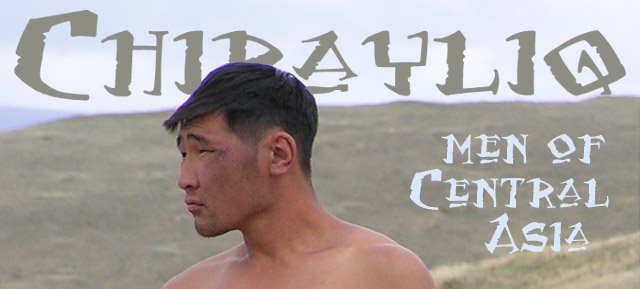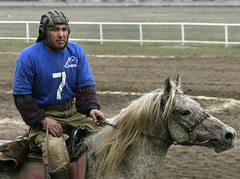Sunday 16 December 2007
To each their own Chirayliq radio
I added my own Chirayliq radio. We haven't got that much content yet, so if one runs out of content, maybe the other one will still play.
Friday 30 November 2007
Gaziz Ajdarskij
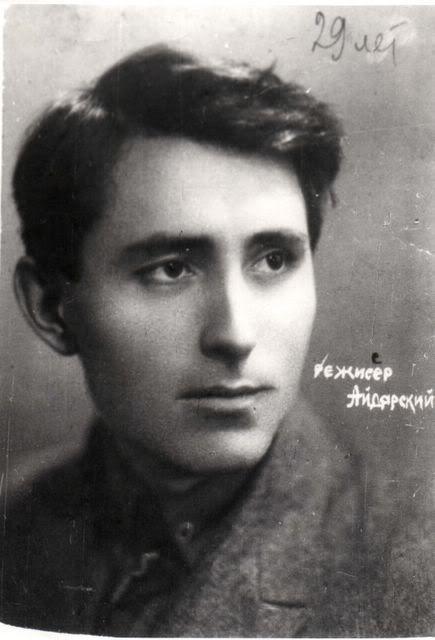
I was reading about Sara Sadiqova, "the Tatar nightingale", on Wikipedia, and discovered through sarasadykova.ru that this beautiful lady had a matching husband. Gaziz Ajdarskij* was an actor and director (and apparently also a poet?) in Kazan and Moscow in the 1920's.
Above, a portrait from 1928. Below, in the role of Takhir in Fatkhi Burnash's "spectacle" Takhir and Zukhra (Tatar akademik G.Kamal isemle teatr, Kazan 1921).
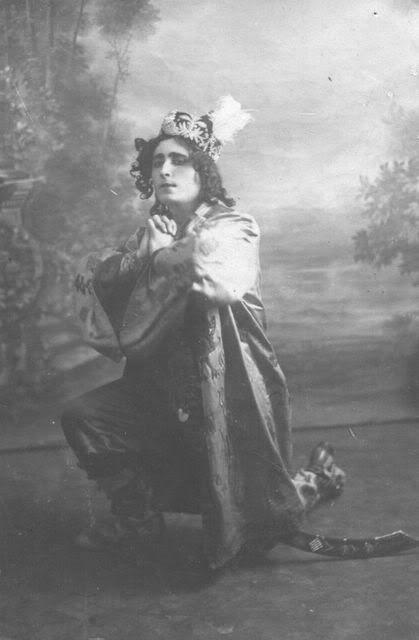
(*Aidarskii, Aydarsky, how are you supposed to translitterate into English in any logical way?...)
Friday 23 November 2007
EURO 2008

I guess we at Chirayliq have to start paying attention to the European football championships in Austria and Switzerland next year. Turkey qualified for the games with 1:0 against Bosnia-Herzegovina. Unfortunately, Kazakhstan, Armenia, Azerbaijan and Georgia couldn't make it, but Russia might have some interesting faces in the team.
More about the results in the qualification pool at Spiegel.de
Friday 9 November 2007
Prince of Tennis: Marat Safin
Every other post seems to be about a Tatar lately, but when I was researching Rustem Hayroudinoff before, I checked out the "List of Tatars" at Wikipedia, and realised that we haven't featured Marat Safin yet.

Marat Safin is a Russian Tatar born in Moscow. He held the "No. 1" world ranking for nine weeks in November and December of 2000, at twenty years of age. His parents are former tennis players and coaches, and his sister Dinara is also a professional tennis player. At age fourteen he moved to Spain to pursue tennis at a higher level than was possible in Russia at the time.
"He is known for his good looks, large physical size, athleticism, controversial antics, and aggressive 'power' style of play. He is fluent in Russian, English and Spanish", Wikipedia informs us.
He's not supercute, at least to me (his nose is much too small), but he's not too bad for a tennis player. ^_^

When Marat is angry, he likes to throw his racquet on the ground. Yes, I can understand that a sport like tennis can be frustrating.
He is quite famous for his emotional outbursts. Especially Fabrice Santoro is able to drive him crazy - according to Marat, "being told I would play Santoro was being told I was to die". Now now, Marat, it can't be that bad, can it? It's just a little ball made of rubber and felted fabric ...

Young Marat (left) at his first tournament, in Tashkent, wearing traditional garb ... which doesn't really go so well with tennis shoes and tennis socks:

The above photos are from Marat's official website. There are LOTS more over there.
Marat being tall (193 cm):

Of course, fanboys and fangirls have also spread less dressed images of Marat all over the Internet:

(Argh, in these photos he looks a bit like this cute French guy I met at a party and then lost, after stupidly not asking for any contact details and even forgetting his name. But the French guy's nose was bigger and he had more beautiful eyes.)
That's a barcode tattooed on Marat's shoulder, under the eye. I wonder what would happen if you'd try to scan him with one of those price checking devices they have in supermarkets ...

The bloggers who posted these pictures weren't at all interested in the two other guys, so I don't know who they are.


Marat Safin is a Russian Tatar born in Moscow. He held the "No. 1" world ranking for nine weeks in November and December of 2000, at twenty years of age. His parents are former tennis players and coaches, and his sister Dinara is also a professional tennis player. At age fourteen he moved to Spain to pursue tennis at a higher level than was possible in Russia at the time.
"He is known for his good looks, large physical size, athleticism, controversial antics, and aggressive 'power' style of play. He is fluent in Russian, English and Spanish", Wikipedia informs us.
He's not supercute, at least to me (his nose is much too small), but he's not too bad for a tennis player. ^_^

When Marat is angry, he likes to throw his racquet on the ground. Yes, I can understand that a sport like tennis can be frustrating.
He is quite famous for his emotional outbursts. Especially Fabrice Santoro is able to drive him crazy - according to Marat, "being told I would play Santoro was being told I was to die". Now now, Marat, it can't be that bad, can it? It's just a little ball made of rubber and felted fabric ...

Young Marat (left) at his first tournament, in Tashkent, wearing traditional garb ... which doesn't really go so well with tennis shoes and tennis socks:

The above photos are from Marat's official website. There are LOTS more over there.
Marat being tall (193 cm):

Of course, fanboys and fangirls have also spread less dressed images of Marat all over the Internet:

(Argh, in these photos he looks a bit like this cute French guy I met at a party and then lost, after stupidly not asking for any contact details and even forgetting his name. But the French guy's nose was bigger and he had more beautiful eyes.)
That's a barcode tattooed on Marat's shoulder, under the eye. I wonder what would happen if you'd try to scan him with one of those price checking devices they have in supermarkets ...

The bloggers who posted these pictures weren't at all interested in the two other guys, so I don't know who they are.

Thursday 8 November 2007
Iosif Vissarionovich
Well, we already have a tag called "Stalin", and Stalin used to be quite the babe when he was young, so it was only a question of time until we would get to this. (We have a "Lenin" tag, too, but Lenin wasn't that attractive - he lost his hair very early and was generally rather asexual - as opposed to the womanizer Stalin, who kept the thick hair on his head until his death.)
Stalin in 1902, at age 24:


These are mug shots by the police in Batumi, where he was arrested for organising several large workers’ demonstrations.
(The first photo, according to Wikimedia commons, is from the book "Josef Wissarionowitsch Stalin - Kurze Lebensbeschreibung", Publishing for Russian literature in foreign languages, Moscow 1947", and the second was featured in E. Radziński's "Stalin. Pierwsza pełna biografia oparta na rewelacyjnych dokumentach z tajnych archiwów rosyjskich", Warszawa 1996.)

In 1919, at age 41, with comrades Lenin and Kalinin at the VIII Congress of the Communist Party of the Soviet Union, Stalin was still kind of good-looking. Or maybe this photo was retouched.
Unfortunately, Stalin suffered many abuses during his childhood and youth, was apparently just generally a bit of an a*****e, and ended up a grown-up with severe psychological problems, which turned out to be lethal for an immense number of people when he gained more and more power in the Soviet Union. (His story is quite typical for many politicians, though maybe a bit extreme.)
Those who in spite of everything would like to feel a bit of sympathy towards him might be interested in Vladimir Sorokin's novel "Blue Lard", where Stalin gets to show a soft spot in his mad love affair with a rather dominant Khruschev.
Stalin in 1902, at age 24:


These are mug shots by the police in Batumi, where he was arrested for organising several large workers’ demonstrations.
(The first photo, according to Wikimedia commons, is from the book "Josef Wissarionowitsch Stalin - Kurze Lebensbeschreibung", Publishing for Russian literature in foreign languages, Moscow 1947", and the second was featured in E. Radziński's "Stalin. Pierwsza pełna biografia oparta na rewelacyjnych dokumentach z tajnych archiwów rosyjskich", Warszawa 1996.)

In 1919, at age 41, with comrades Lenin and Kalinin at the VIII Congress of the Communist Party of the Soviet Union, Stalin was still kind of good-looking. Or maybe this photo was retouched.
Unfortunately, Stalin suffered many abuses during his childhood and youth, was apparently just generally a bit of an a*****e, and ended up a grown-up with severe psychological problems, which turned out to be lethal for an immense number of people when he gained more and more power in the Soviet Union. (His story is quite typical for many politicians, though maybe a bit extreme.)
Those who in spite of everything would like to feel a bit of sympathy towards him might be interested in Vladimir Sorokin's novel "Blue Lard", where Stalin gets to show a soft spot in his mad love affair with a rather dominant Khruschev.
Tuesday 6 November 2007
Rustem Hayroudinoff
Our avid reader Ilshat suggested another nice guy to be featured on Chirayliq, though his e-mail has been lying around in my mailbox for a very long time. Shame on me.
Rustem Hayroudinoff (aka Rustem Hayrutdinov, aka Röstäm Xäyretdin Äwzal ulı) is a Tatar and a world-famous classical pianist, born in Kazan into a family full of musicians.

He reminds a bit of a certain Tatar film maker acquaintance of mine.

(Second photo by Terence Donovan, collage used as a part of playbill cover for Rustem Hayroudinoff’s concert on October 18, 2007 at the Lütfi Kırdar Congress and Exhibition Center's Grand Hall, Istanbul, Turkey.)
Read more about Rustem and hear a short sample of his "Prelude in G Minor" by Rachmaninov.
Rustem Hayroudinoff (aka Rustem Hayrutdinov, aka Röstäm Xäyretdin Äwzal ulı) is a Tatar and a world-famous classical pianist, born in Kazan into a family full of musicians.

He reminds a bit of a certain Tatar film maker acquaintance of mine.

(Second photo by Terence Donovan, collage used as a part of playbill cover for Rustem Hayroudinoff’s concert on October 18, 2007 at the Lütfi Kırdar Congress and Exhibition Center's Grand Hall, Istanbul, Turkey.)
Read more about Rustem and hear a short sample of his "Prelude in G Minor" by Rachmaninov.
Monday 5 November 2007
Malen'kye Lyudi - Kazakhstan 2003
Malen'kye Lyudi by Nariman Turebayev (2003) is a movie about "little people", friends Bek and Max, who share an apartment in Almaty and just try to survive on odd jobs and daydreams. Bek (Erjan Bekmuratov) wants to find true love, Max (Oleg Kerimov) wants to move to Germany, where his grandmother lives.



Another film from Kazakhstan distributed by Trigon Film in Europe is Killer / Marat, tueur à gages by Dareshan Omirbayev, 1999. Reluctant assassin Marat (incredibly handsome Talgat Assetov) is captured in the Mafia's net of extortion, lies and violence.


«Max ist ein Frauenheld, Bek ein stiller Brüter, und den Moment, in dem sie ihre Liebe zueinander entdecken, nur um sich sofort wieder voneinander zurückzuziehen, inszeniert Turebayev grossartig.»
Frankfurter Allgemeine Zeitung



Another film from Kazakhstan distributed by Trigon Film in Europe is Killer / Marat, tueur à gages by Dareshan Omirbayev, 1999. Reluctant assassin Marat (incredibly handsome Talgat Assetov) is captured in the Mafia's net of extortion, lies and violence.
"Dareschan Omirbaew hat in drei Spielfilmen sein leidenschaftliches Temperament gezeigt und ein Kino von einer unleugbaren Poesie."
Thierry Jousse, Cahiers du Cinéma


Wednesday 24 October 2007
Teuvo Tulio - Theodor Tugai
 Extracts from my short biography at historia.ainurin.net:
Extracts from my short biography at historia.ainurin.net:- born Theodor Antonius Tugai in St Petersburg August 23, 1912, childhood in Latvia
- moved to Finland after his mother’s second marriage to a Finn; grew up in Helsinki
- became one of Finland’s most influential film directors and producers after an early career as silent film star
Read more...

In an impressive fur hat, and uniform

In uniform again; this looks more like the grey coat of the Finnish army

Valentinoesque profile

Tulio - levottoman veren antologia is an antholgy of Tulio scholarship and "poetic visions" inspired by his work, published by SKS. (A review in Helsingin Sanomat)
Sunday 14 October 2007
Ola Wong on Mongolian men in Swedish daily Svenska Dagbladet
Ola Wong is a Chinese-Romanian guy born in Borås, Sweden, who works as a journalist and has also written a really interesting book about his grandparents ("No, I'm from Borås"). Today an article by him about Mongolian men was published in Swedish daily newspaper Svenska Dagbladet.
Wong describes how the role of the Mongolian man is in a downward spiral. The case of Oynaa's family is one example of many. "The worst thing about Mongolian men is that they drink, are lazy and unfaithful. Then they bring sexually transmitted diseases back home. And he blamed the disease on me, even though I was toiling like crazy to take care of the child, our home and work at the same time", complains Oynaa, a divorced mother whom Wong interviewed in Ulan Bator. After the divorce, Oynaa's husband left her their child and kept their apartment for himself. But Oynaa went on to make a career and is now the manager of a fitness club, while her ex-husband lives off his parents.
"Oynaa blames the problems in Mongolia on the fact that the men are still mentally in the ger - the Mongolian felt tent [in SvD entertainingly enough misspelled as "sour milk tent"], where the warmest half is reserved for the men and the altar. The Mongolian ideal man is a carefree and indolent wrestler type who never takes initiatives or is in any hurry. He should sit there with his legs apart and with his hands on his knees. A woman, on the other hand, should be intelligent, hardworking, good at cooking and cleaning, beautiful, modest, quiet and submissive - all at the same time!"
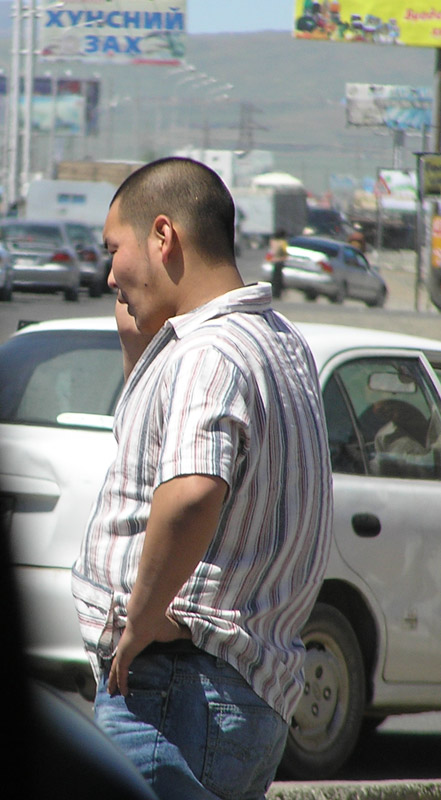 Wong writes about how 70 % of university students are women. He cites a common explanation for this - that people tend to think that "boys will be all right anyway", while girls are married off to another family, and their parents consider them to need an education to be able to stand on their own legs.
Wong writes about how 70 % of university students are women. He cites a common explanation for this - that people tend to think that "boys will be all right anyway", while girls are married off to another family, and their parents consider them to need an education to be able to stand on their own legs.
In spite of this, women's influence in the higher levels of society has diminished considerably since "democracy" came along in 1990 - only 7 % of the Mongolian members of parliament are women today.
While this article could have been interesting as a more personal insight into the life of Oynaa's family and many more like them in Mongolia today, Wong goes on to draw simplified conclusions about Mongolian culture and history. "Macho ideals and hard men made it possible for the Mongolians to conquer a world empire under Genghis Khan. But it became a recipe for failure after the fall of the Soviet Union. The men gave up, got wasted and took out their frustration with their fists."
(So, nothing else really happened between Genghis Khan and 1990?)
Instead of drawing slightly orientalist conclusions about Genghis Khan, it should be easy to see the same pattern here as in Russia and many other post-Communist countries, where the transition has hit men harder - many of them drink and get violent in frustration, while a handful go on to rule the country. Women, on the other hand, keep on coping somehow, as they always have.
Certainly, there are exceptions to this bleak picture. And Wong writes about how in order to support men, the Mongolian Men's Association was founded. Since one year it has been obligatory for engaged couples to take at the very least a two-hour class at the Mongolian Men's Association before they are allowed to marry.
So, by and by, I guess maybe even Mongolian men will be able to show a "softer" side. They could start with changing the design of their saddles. The traditional Mongolian saddles are said to be made as uncomfortable as possible, so that the riders "stay hard", like "real men". My arse still hurts when I think about them.
(Photo by me, Ulan Bator, June 2006 - the guy on the photo obviously has nothing to do with the article, except that he is a specimen of The Mongolian Man.)
Wong describes how the role of the Mongolian man is in a downward spiral. The case of Oynaa's family is one example of many. "The worst thing about Mongolian men is that they drink, are lazy and unfaithful. Then they bring sexually transmitted diseases back home. And he blamed the disease on me, even though I was toiling like crazy to take care of the child, our home and work at the same time", complains Oynaa, a divorced mother whom Wong interviewed in Ulan Bator. After the divorce, Oynaa's husband left her their child and kept their apartment for himself. But Oynaa went on to make a career and is now the manager of a fitness club, while her ex-husband lives off his parents.
"Oynaa blames the problems in Mongolia on the fact that the men are still mentally in the ger - the Mongolian felt tent [in SvD entertainingly enough misspelled as "sour milk tent"], where the warmest half is reserved for the men and the altar. The Mongolian ideal man is a carefree and indolent wrestler type who never takes initiatives or is in any hurry. He should sit there with his legs apart and with his hands on his knees. A woman, on the other hand, should be intelligent, hardworking, good at cooking and cleaning, beautiful, modest, quiet and submissive - all at the same time!"
 Wong writes about how 70 % of university students are women. He cites a common explanation for this - that people tend to think that "boys will be all right anyway", while girls are married off to another family, and their parents consider them to need an education to be able to stand on their own legs.
Wong writes about how 70 % of university students are women. He cites a common explanation for this - that people tend to think that "boys will be all right anyway", while girls are married off to another family, and their parents consider them to need an education to be able to stand on their own legs.In spite of this, women's influence in the higher levels of society has diminished considerably since "democracy" came along in 1990 - only 7 % of the Mongolian members of parliament are women today.
While this article could have been interesting as a more personal insight into the life of Oynaa's family and many more like them in Mongolia today, Wong goes on to draw simplified conclusions about Mongolian culture and history. "Macho ideals and hard men made it possible for the Mongolians to conquer a world empire under Genghis Khan. But it became a recipe for failure after the fall of the Soviet Union. The men gave up, got wasted and took out their frustration with their fists."
(So, nothing else really happened between Genghis Khan and 1990?)
Instead of drawing slightly orientalist conclusions about Genghis Khan, it should be easy to see the same pattern here as in Russia and many other post-Communist countries, where the transition has hit men harder - many of them drink and get violent in frustration, while a handful go on to rule the country. Women, on the other hand, keep on coping somehow, as they always have.
Certainly, there are exceptions to this bleak picture. And Wong writes about how in order to support men, the Mongolian Men's Association was founded. Since one year it has been obligatory for engaged couples to take at the very least a two-hour class at the Mongolian Men's Association before they are allowed to marry.
So, by and by, I guess maybe even Mongolian men will be able to show a "softer" side. They could start with changing the design of their saddles. The traditional Mongolian saddles are said to be made as uncomfortable as possible, so that the riders "stay hard", like "real men". My arse still hurts when I think about them.
(Photo by me, Ulan Bator, June 2006 - the guy on the photo obviously has nothing to do with the article, except that he is a specimen of The Mongolian Man.)
Tuesday 9 October 2007
Ulak-Tartysh part 2!
I don't know if the guys at englishrussia.com read Chirayliq, but they recently also had an entry about the great game of "grabbing the goat", with photos from various games. Here is a small selection (click for original size):




The guy in the purple shirt is my favourite:

There are many more pictures in the original post at englishrussia.com, but - as always with that blog - read the comments at your own risk ...
(Photos #2 and #3 are definitely from Kyrgyzstan, but the rest are only *probably* from the same country, as the sources don't cite their sources, so to speak.)




The guy in the purple shirt is my favourite:

There are many more pictures in the original post at englishrussia.com, but - as always with that blog - read the comments at your own risk ...
(Photos #2 and #3 are definitely from Kyrgyzstan, but the rest are only *probably* from the same country, as the sources don't cite their sources, so to speak.)
Friday 28 September 2007
Sweet-talking son of a shaman man
In the photo gallery of ethno-online.ru I found this young man. The photo is part of a reportage about Nganasan shamans from the 1970's to the 1990's, it seems. Nganasans are one of the indigenous peoples of Siberia, living on the Taymyr Peninsula in the Arctic Ocean (not that far from the Nenets guys Viktor and Nikolai).

The notes around the photo say:
"This is the son of Tubyaku - Leonid, in Nganasan language Labtymyaku. Of his own accord, he dressed in his father's shaman clothes in order to rise up to the higher gods, and thus invoked his [father's] anger, because he had no connections to the shaman spirits.
Five years after his father's death, Leonid would start trying to practise shamanism for himself and his family."
Around another photo in the gallery it is written about how Leonid's father Tubyaku died. "Like a true Nganasan man he did not know how to handle fire, because the hearth is women's work. He just burned up when his daughters went away [illegible] a holiday."
P.S. The gallery is buggy. It's most easily navigated if you just manually change the number at the end of the URL on the first photo page to see the next photo - from 20 to 21, 22, 23 etc.

The notes around the photo say:
"This is the son of Tubyaku - Leonid, in Nganasan language Labtymyaku. Of his own accord, he dressed in his father's shaman clothes in order to rise up to the higher gods, and thus invoked his [father's] anger, because he had no connections to the shaman spirits.
Five years after his father's death, Leonid would start trying to practise shamanism for himself and his family."
Around another photo in the gallery it is written about how Leonid's father Tubyaku died. "Like a true Nganasan man he did not know how to handle fire, because the hearth is women's work. He just burned up when his daughters went away [illegible] a holiday."
P.S. The gallery is buggy. It's most easily navigated if you just manually change the number at the end of the URL on the first photo page to see the next photo - from 20 to 21, 22, 23 etc.
Wednesday 26 September 2007
Viktor and Nikolai
This past weekend, Australian Tim Cope finished his long journey on the trail of Genghis Khan - from Mongolia to Hungary by horse. It was by far not his first adventure.
In June 2001, Tim and his three friends Colin, Remy and Ben rowed a boat down the Yenisey river, from lake Baikal to the Kara Sea, over the course of four months. Just 20 km from the end of their journey, they stayed for two days with the families of Viktor and Nikolai, Nenets reindeer herders and hunters living on a small island in the Yenisey gulf.

Viktor

Nikolai

Nikolai, his mother and a doggie

Viktor, his son, and their neighbour Nikolai in the icy wind.

"Nikolai moves forward through the swampy stand of grass and dwarf birch with the prowess and elegance of an experienced hunter", Tim writes.

At the end of the journey, Tim and his companions arranged for Nikolai and his family to meet them in the gulf to help them get a lift back south. Here, Nikolai is holding the Australian flag, mounted on one of the oars, ready to take pictures at the finishing point of the journey, where the Yenisey river meets the ocean.
More about the Yenisey journey!
In June 2001, Tim and his three friends Colin, Remy and Ben rowed a boat down the Yenisey river, from lake Baikal to the Kara Sea, over the course of four months. Just 20 km from the end of their journey, they stayed for two days with the families of Viktor and Nikolai, Nenets reindeer herders and hunters living on a small island in the Yenisey gulf.

Viktor

Nikolai

Nikolai, his mother and a doggie

Viktor, his son, and their neighbour Nikolai in the icy wind.

"Nikolai moves forward through the swampy stand of grass and dwarf birch with the prowess and elegance of an experienced hunter", Tim writes.

At the end of the journey, Tim and his companions arranged for Nikolai and his family to meet them in the gulf to help them get a lift back south. Here, Nikolai is holding the Australian flag, mounted on one of the oars, ready to take pictures at the finishing point of the journey, where the Yenisey river meets the ocean.
More about the Yenisey journey!
Saturday 22 September 2007
Ulak-tartysh!
Buzkashi, Kökbörü or Oglak-Tartis (Persian: بزکشی bozkæšī, Tajik: бузкашӣ buzkašī: goat grabbing) (Uzbek, Tatar, Turkmen: kökbörü, kök "blue" + börü "wolf", Kazakh: көкпар kökpar, Kyrgyz: улак-тартыш ulak-tartyš) is a traditional Central Asian team sport played on horseback. (See Wikipedia.)
It is a popular sport all over Central Asia, and has been adopted as "polo" in some other parts of the world.
One of the differences between the Central Asian and the Western versions of the game is that in the West, you use a ball and a club, while in the East, you use a dead goat or sheep and your bare hands. Certainly this shows that Central Asian men are just tougher.
(Those who think using a dead goat or sheep is somehow terrible might want to consider whose hide your average leather football is made of. At least the goats and sheep have not been manufactured in sweatshops using underpaid child labour.)
Here, I'll focus on photos of Ulak-Tartysh as it is played in Kyrgyzstan. (I was, of course, researching for this post when I came across the guys in the post below ...)
Christopher Herwig has photographed a game of Ulak-Tartysh at a hippodrome outside Bishkek. Here is the whole set and his description at Flickr. Highlights (click for full size):
The players are wearing hockey helmets, or no helmets at all. The leather variations look like Russian/Soviet tank soldier helmets, but are actually old-style leather hockey helmets (our dad used to have helmets like that at some point).
Some particularly cute guys grabbing the goat, photographed by Jonathan Wilson at Trekearth.com (click for full size):

Ronald de Hommel has a quite interesting website with photoreportages from many parts of the world. While in Kyrgyzstan, he also covered Ulak-Tartysh:


The doggies also participate.
It is a popular sport all over Central Asia, and has been adopted as "polo" in some other parts of the world.
One of the differences between the Central Asian and the Western versions of the game is that in the West, you use a ball and a club, while in the East, you use a dead goat or sheep and your bare hands. Certainly this shows that Central Asian men are just tougher.
(Those who think using a dead goat or sheep is somehow terrible might want to consider whose hide your average leather football is made of. At least the goats and sheep have not been manufactured in sweatshops using underpaid child labour.)
Here, I'll focus on photos of Ulak-Tartysh as it is played in Kyrgyzstan. (I was, of course, researching for this post when I came across the guys in the post below ...)
Christopher Herwig has photographed a game of Ulak-Tartysh at a hippodrome outside Bishkek. Here is the whole set and his description at Flickr. Highlights (click for full size):
The players are wearing hockey helmets, or no helmets at all. The leather variations look like Russian/Soviet tank soldier helmets, but are actually old-style leather hockey helmets (our dad used to have helmets like that at some point).
Some particularly cute guys grabbing the goat, photographed by Jonathan Wilson at Trekearth.com (click for full size):

Ronald de Hommel has a quite interesting website with photoreportages from many parts of the world. While in Kyrgyzstan, he also covered Ulak-Tartysh:


The doggies also participate.
Kyrgyz men on TrekEarth.com
TrekEarth.com is a very nice website with the concept "Learning about the world through photography". I can spend hours browsing its galleries.
Here are a few Kyrgyz men from its Kyrgyzstan section. Click the links for the photographers' descriptions.

"Living on the top" by Lukas geez

"Mid-air" by Kristen Elsby

"The Roast Continues" by Ryan Smith

"Kyrgyz horseman" by Robin Merrifield
Here are a few Kyrgyz men from its Kyrgyzstan section. Click the links for the photographers' descriptions.

"Living on the top" by Lukas geez

"Mid-air" by Kristen Elsby

"The Roast Continues" by Ryan Smith

"Kyrgyz horseman" by Robin Merrifield
National Geographic
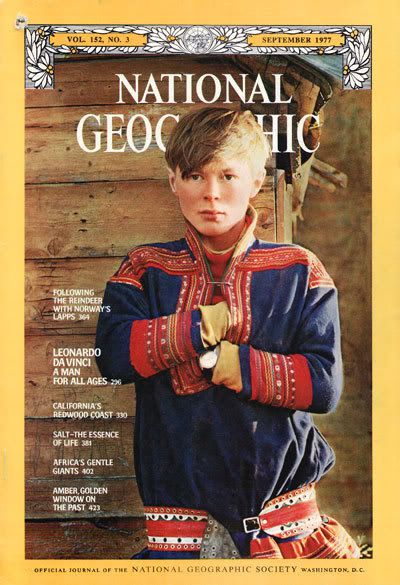
Once upon a time, I collected old National Geographics for my source library. For fun, I checked them for any Chirayliq material. Surely they - from 1963 to 1999 - would yield some treasures.
Of course, it wasn't so easy. Western ethnographers don't usually pay much attention to handsome men between 18 and 38, regardless what tribe or nation they might be photographing. The "normal" targets for National Geographic photoshoots are old, wizened grandpas, beautiful women, and children of both sexes. Thus, my chirayliq collection consists of two teenage boys, two men well into their middle age, and only a single one of our own age group.
The Sami boy at the top, Nils Johan Mienna (15 years old in 1977) represents the western edge of our dear Eurasian landmass. Reindeer herders inhabit the continent's rim all the way from Norway to East Siberia. I wonder if Nils wanted to continue his parents' traditions, or if he pursued other dreams. Typical of 1970's National Geographic, the article makes a big deal out of the demands of "modern" life and suggests that reindeer herding will be lost for the sake of efficiency.
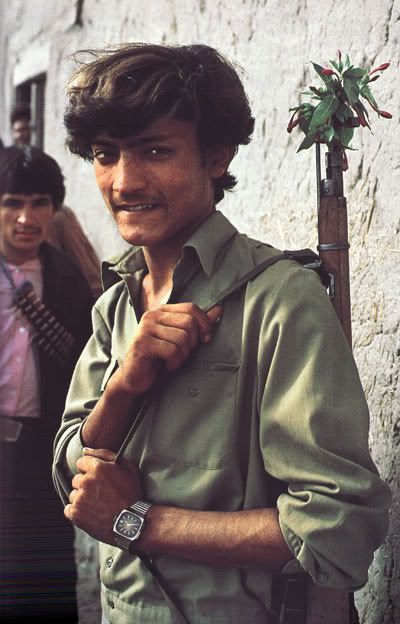
From National Geographic's April issue, 1985, comes this portrait of an anonymous Afghani boy. He is described as a militiaman in a village near "Communist Kabul". The writer lets us know that the Marxist government conscripts 16-year-olds, and that the army is plagued by desertions. While Coca Cola continued to flow in the capital, the surrounding mujaheddin were dealing another kind of opium for the people. I wonder what happened to this young man.
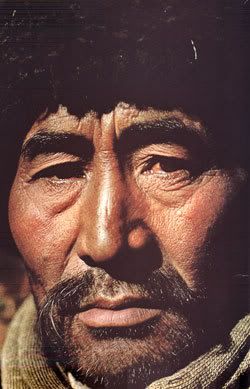
Towards the heart of the continent: A Kyrgyz herdsman reminds a French couple of his ancestor, Genghis Khan, on their way through the Wakhan corridor in 1972. It is not made clear if he is identical to their guide, Abdul Wakil, a man of few words and fewer smiles, but with unerring survival experience. Of course, the travellers respect Abdul, their life depends on him, but they also suggest that he doesn't understand how a jeep could be more valuable than 14 of his beloved camels.

13 years later, another "descendant of the Khan" greets the National Geographic reporters with a Mona Lisa smile. Of course, the article is titled "Time Catches Up With Mongolia". There is nothing more reassuring for the Western reporters than the good old contrast between the backward but oh-so-authentic East, and the up-to-date but boringly normal West. Is modernization through sovietizised city slickers of Ulan Bator more wrong than Coca Cola in Kabul?
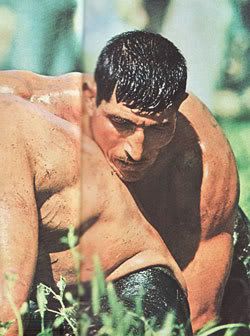
The final photo is from an article from 1968, "In the Footsteps of Alexander the Great". A Turkish oil wrestling contest takes place amid the ruins of Ephesus. Here, back in the Western end of Eurasia, Turks act out the roles of ancient Greeks and Macedonians in the imagination of the reporter.
Subscribe to:
Posts (Atom)
